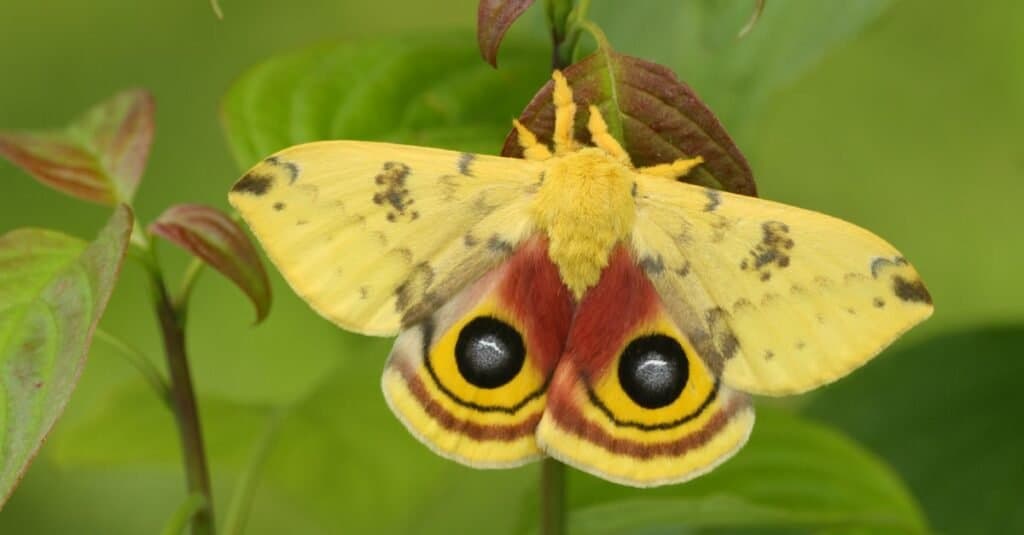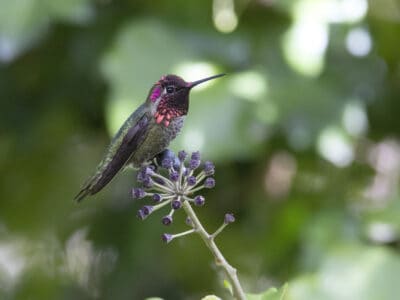Io Moth
Automeris io
The larvae of the Io Moth has a poisonous and painful sting.
Advertisement
Io Moth Scientific Classification
- Kingdom
- Animalia
- Phylum
- Arthropoda
- Class
- Insecta
- Order
- Lepidoptera
- Family
- Saturniidae
- Genus
- Automeris
- Scientific Name
- Automeris io
Read our Complete Guide to Classification of Animals.
Io Moth Conservation Status
Io Moth Facts
- Name Of Young
- Caterpillar
- Group Behavior
- Solitary
- Fun Fact
- The larvae of the Io Moth has a poisonous and painful sting.
- Most Distinctive Feature
- eyespots on hind wings
Io Moth Physical Characteristics
- Color
- Brown
- Yellow
- Red
- Dark Brown
- Lifespan
- 7-14 days
- Length
- 63mm to 88mm
- Venomous
- No
- Aggression
- Low
View all of the Io Moth images!
The larvae of the Io moth have a poisonous and painful sting.
Summary
Also known as the peacock moth, the Io moth is a beautiful moth native to the North American continent. Arguably one of the most recognizable moth species in the world, Io moths have prominent eyespots on their hind wings. The caterpillar of the Io moth has a unique defense adaptation, a painful venom that protects it against predators. The Io moth used to be widespread across various locations in North America. However, in recent years, the moth has become less common in most of its range.
Io Moth Species, Types, and Scientific Name
Io moth (Automeris io) is a colorful moth of the family Saturniidae, a family which includes giant silkworms and royal moths. It belongs to the order Lepidoptera along with other butterflies and moths. The genus Automeris, to which this moth belongs, is a large genus with 145 species of moths. All species in this genus have prominent eyespots on the hind wings. Most species occur in the Americas, but the Io moth is native to North America.
The name Io derives from the name of a Greek goddess, who was the mortal lover of the god Zeus. Lesser-known common names for this moth include the corn emperor moth and peacock moth.
Like many moths, adult peacock moths have a short lifespan, and they do not feed during their short lifespan, which typically lasts between 1-2 weeks. The moth has particularly interesting defenses. The caterpillars of these moths have stinging spines that release painful venom. Adults also use their hindwing eyespots as a form of defense to deter predators.
Appearance: How to Identify Io Moth

A male Io moth, with the giant set of eyes that it develops as a sophisticated defense mechanism.
©Kevin Collison/Shutterstock.com
Adult Io moths have an average wingspan of 2.5–3.5 inches (63–88 mm). The species is sexually dimorphic, which means male and female peacock moths have different appearances. Females are typically larger than males. Their antennas are also slightly different. The color of the forewings is also somewhat different for males and females. Males of this moth are yellowish, while females are mostly brown, purplish, or rusty red.
Io moths rest with their wings flattened to the sides and spread over their backs. When disturbed, they usually part their forewings and hindwings to reveal large eye spots.
The color of the larvae varies depending on the stage of development. They’re reddish-brown at first, but this gradually turns yellowish-brown as the caterpillar develops. At full maturity, the larvae are typically yellowish-green or bluish-green. Their body is covered in thick bristles with stinging spines that release an irritating venom.
Mature larvae are yellowish-green to bluish-green with a red-and-white stripe on the sides. They have a lot of thick bristly, stinging spines on their body that cause severe irritation in some people. The pupa of the Io moth is typically dark brown. The appearance of the pupa varies depending on whether it’s a male moth or female. Young larvae of this moth stay in groups. However, they become more solitary as they mature and develop into adult moths.
Habitat: Where To Find Io Moths
The Io moth is native to North America. It is most commonly found in the Southern Canada area as well as in the eastern United States. They have also been found in some parts of eastern Mexico. In places where they occur, they live in a variety of habitats. However, you’re more likely to encounter these moths in forests and parklike areas. The caterpillar of this moth is polyphagous, which means it can take various plants as hosts. However, experts think they demonstrate regional preferences for the plants they choose as hosts.
Diet: What Do Io Moths Eat?
Adult peacock moths, like other members of the silk moth family, do not feed during their short lifespan. They only live for 1 to 2 weeks and do not feed throughout this period because their mouthparts are reduced. The Larvae are known to feed activity on various plants. This includes herbaceous plants, grasses, some deciduous trees, shrubs, and conifers.
Their choice of host plant varies from one location to the other. In the Ozarks, for instance, Io moth larvae choose sassafras trees as their host. But in places like Missouri, the moth has been found in more than 30 tree species.
Related Animals
View all 39 animals that start with IIo Moth FAQs (Frequently Asked Questions)
Are Io Moths dangerous?
Adult Io Moths are practically harmless to humans. However, the larvae of this insect have spines covering their entire body. The spines are connected to poison glands which it uses as a form of self-defense against humans. Although the poison isn’t strong enough to kill humans, the sting causes a painful sensation similar to a bee sting. Pain typically lasts for a few hours.
Is Io moth rare?
Io moths used to be very popular across several locations in North America. However, like many other moths in the family Saturniidae, Io moths are becoming less common in parts of its typical range.
How do you identify Io Moths?
Adult Io moths have a wingspan of about 2–3¼ inches. Female members of this species are typically larger than males. Their most notable feature is the presence of a single blue or black colored moth on each hind wing. The males typically have a yellowish color while females can be brown, rusty red, or purplish in color. The caterpillars are green to yellow in color. They have sharp bristles that can deliver a painful sting all over their body.
What does a lo moth eat?
Like many species of moths, Adult Io Moths do not feed during their short-lived life. Larvae feed on various trees, grasses and shrubs.
How long does an Io moth live?
Io moths have a short lifespan. Once they emerge from their cocoons, the moth only lives for 7-14 days before dying off.
Thank you for reading! Have some feedback for us? Contact the AZ Animals editorial team.
Sources
- Wikipedia, Available here: https://en.wikipedia.org/wiki/Automeris_io
- University of Florida, Available here: https://entnemdept.ufl.edu/creatures/misc/io_moth.htm
- Butterflies and Moths of North America, Available here: https://www.butterfliesandmoths.org/species/automeris-io
- Bugwood Wiki, Available here: https://wiki.bugwood.org/HPIPM:IO_Moth

















